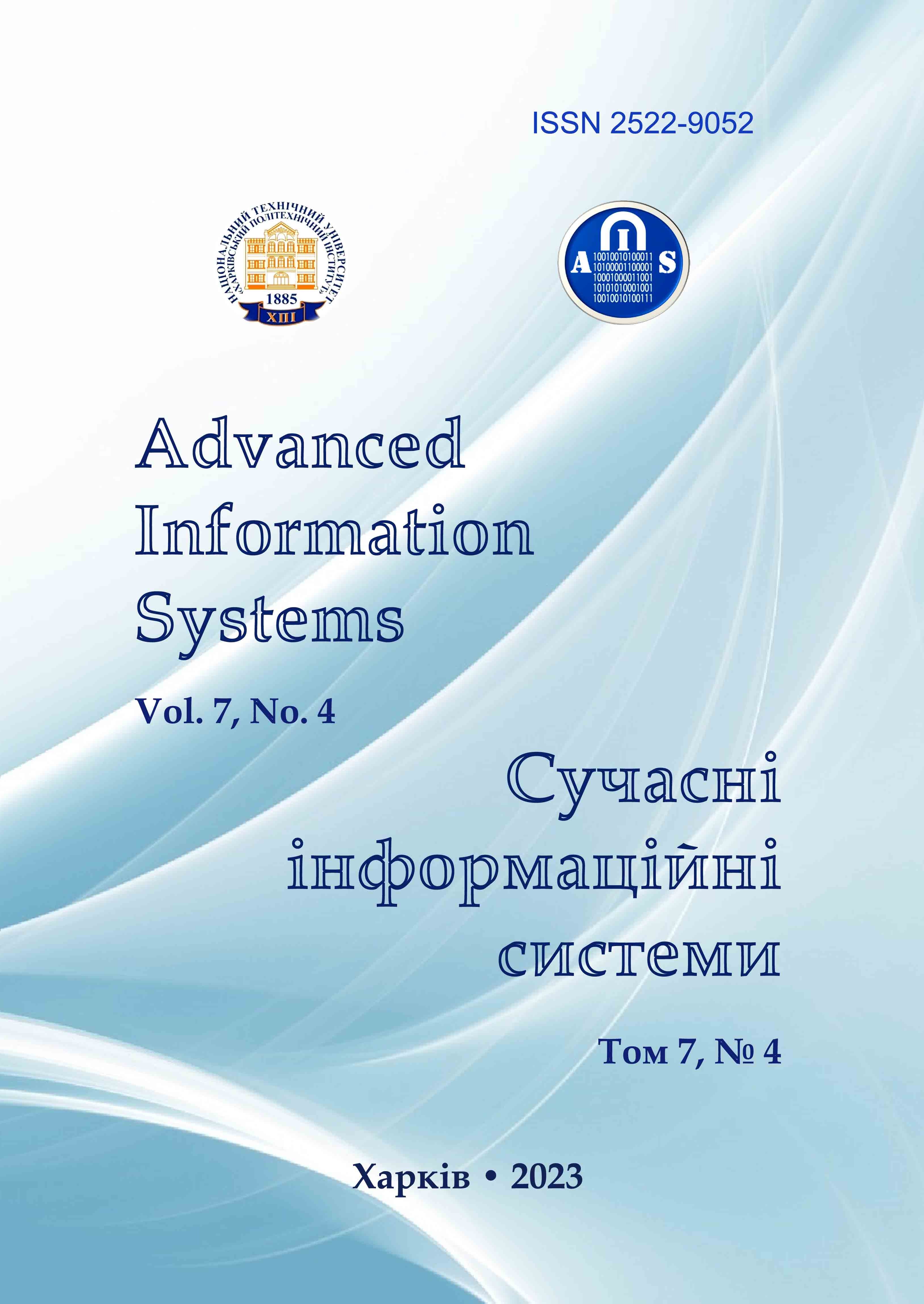APPLICATION OF HETEROGENEOUS ENSEMBLES IN PROBLEMS OF COMPUTER SYSTEM STATE IDENTIFICATION
Main Article Content
Abstract
The object of the study is the process of identifying anomalies in the operation of a computer system (CS). The subject of the study is ensemble methods for identifying the state of the CS. The goal of the study is to improve the performance of ensemble classifiers based on heterogeneous models. Methods used: machine learning methods, homogeneous and heterogeneous ensemble classifiers, Pasting and Bootstrapping technologies. Results obtained: a comparative analysis of the use of homogeneous and heterogeneous bagging ensembles in data classification problems was carried out. The effectiveness of various approaches to the selection of base ensemble classifiers has been studied. A method for identifying the state of a computer system, based on the heterogeneous bagging ensemble was proposed. Experimental studies made it possible to confirm the main theoretical assumptions, as well as evaluate the efficiency of the constructed heterogeneous ensembles. Conclusions. Based on the results of the study, the method for constructing a heterogeneous bagging ensemble classifier, which differs from known methods in the procedure for selecting base models was proposed. It made possible to increase the classification accuracy. Further development of this research could include the creating and integration of dissimilarity metrics as well as other quantitative metrics for a more accurate and balanced base model selection procedure, which would further improve the performance of the computer system state classifier.
Article Details
References
Gavrylenko, S. and Chelak, V. (2023), “Development of method base on fuzzy decision trees for identification of the computer systems state”, Control, Navigation and Communication Systems, Is. 1(71), pp. 78–83, doi:
https://doi.org/10.26906/SUNZ.2023.1.078
Hornostal, O. and Gavrylenko, S. (2021), “Development of a method for identification of the state of computer systems based on bagging classifiers”, Advanced Information Systems, Vol. 5, no. 4, pp. 5–9, doi: https://doi.org/10.20998/2522-9052.2021.4.01
Hornostal, O. and Gavrylenko, S. (2023), “Method of identifying the state of a computer system based on ensemble classifiers with an improved voting procedure”, Control, Navigation and Communication Systems, Is. 3(73), pp. 79–85, doi: https://doi.org/10.26906/SUNZ.2023.3.079
Kuo-Wei, Hsu (2017), “A Theoretical Analysis of Why Hybrid Ensembles Work”, Computational Intelligence and Neuroscience, Vol. 2017(1), pp. 1–12, doi: https://doi.org/10.1155/2017/1930702
Nascimento, D., Canuto, A., Silva, L. and Coelho A. (2011), “Combining different ways to generate diversity in bagging models: An evolutionary approach”, Proceedings of the International Joint Conference on Neural Networks, pp. 2235–2242, doi: https://doi.org/10.1109/IJCNN.2011.6033507
Feng, Y., Wang, X. and Zhang, J. (2021), “A Heterogeneous Ensemble Learning Method For Neuroblastoma Survival Prediction”, IEEE Journal of Biomedical and Health Informatics, Vol. 26, pp. 1472–1483, doi:
https://doi.org/10.1109/JBHI.2021.3073056
Khreich, W., Murtaza, S. Sh., Hamou-Lhadj, A. and Talhi, C. (2018), “Combining Heterogeneous Anomaly Detectors for Improved Software Security”, Journal of Systems and Software, vol. 137, pp. 415–429, doi:
https://doi.org/10.1016/j.jss.2017.02.050
Gavrylenko, S., Chelak, V. and Hornostal, O. (2022), “Construction Method of Fuzzy Decision Trees for Identification the Computer System State”, Proceedings of the 32th International Scientific Symposium Metrology and Metrology Assurance, pp. 1–5, doi: https://doi.org/10.1109/MMA55579.2022.9992878
Bicego, M., Rossetto, A., Olivieri, M., Londoño-Bonilla, J. and Orozco-Alzate, M. (2022), “Advanced KNN Approaches for Explainable Seismic-Volcanic Signal Classification”, Mathematical Geosciences, Vol. 55, pp. 59–80. doi:
https://doi.org/10.1007/s11004-022-10026-w
Hlavcheva, D., Yaloveha, V., Podorozhniak, A. and Kuchuk, H. (2021), “Comparison of CNNs for Lung Biopsy Images Classification”, 2021 IEEE 3rd Ukraine Conference on Electrical and Computer Engineering, UKRCON 2021 – Proceedings, pp. 1–5, doi: https://doi.org/10.1109/UKRCON53503.2021.9575305
Khreich, W., Khosravifar, B., Hamou-Lhadj, A. and Talhi, C. (2017), “An Anomaly Detection System based on Variable
N-gram Features and One-Class SVM”, Information and Software Technology, Vol. 91, pp. 186–197. doi:
https://doi.org/10.1016/j.infsof.2017.07.009
Kuchuk, N., Mozhaiev, O., Mozhaiev, M. Kuchuk, H. (2017), “Method for calculating of R-learning traffic peakedness”, 2017 4th International Scientific-Practical Conference Problems of Infocommunications Science and Technology, PIC S and T 2017 – Proceedings, pp. 359–362, doi: https://doi.org/10.1109/INFOCOMMST.2017.8246416
Salau A. O., Assegie T. A., Akindadelo A. T. and Eneh, J. N. (2023), “Evaluation of Bernoulli Naive Bayes model for detection of distributed denial of service attacks”, Bulletin of Electrical Engineering and Informatics, Vol. 12, no. 2, pp. 1203–1208, doi: https://doi.org/10.11591/eei.v12i2.4020
Kovalenko, A., Kuchuk, H., Kuchuk, N. and Kostolny, J. (2021), “Horizontal scaling method for a hyperconverged network”, 2021 Int. Conf. on Inf. and Digital Technologies (IDT), Zilina, Slovakia, doi: https://doi.org/10.1109/IDT52577.2021.9497534
Kamarudin, M. H., Maple, C., Watson, T. and Sofian, H. (2015), “Packet Header Intrusion Detection with Binary Logistic Regression Approach in Detecting R2L and U2R Attacks”, Fourth International Conference on Cyber Security, Cyber Warfare, and Digital Forensic (CyberSec), pp. 101–106, doi: http://dx.doi.org/10.1109/CyberSec.2015.28
Dun B., Zakovorotnyi, O. and Kuchuk, N. (2023), “Generating currency exchange rate data based on Quant-Gan model”, Advanced Information Systems, Vol. 7, no. 2, pp. 68–74, doi: http://dx.doi.org/10.20998/2522-9052.2023.2.10
Paul, S. and Kundu, R. K. (2022), “A Bagging MLP-based Autoencoder for Detection of False Data Injection Attack in Smart Grid”, IEEE Power & Energy Society Innovative Smart Grid Technologies Conference (ISGT), pp. 1–5, doi: https://doi.org/10.1109/ISGT50606.2022.9817480
